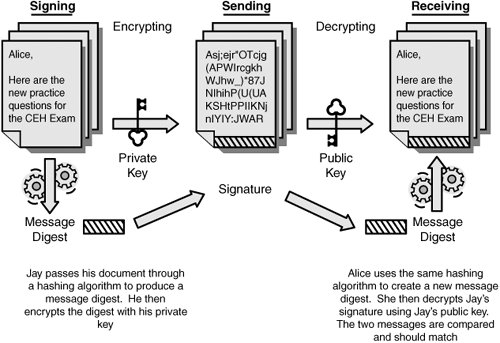Digital Signatures
|
Objective:
|
Up to this point, this Chapter has primarily focused on how symmetric and asymmetric encryption is used for confidentiality. Now let's focus on how asymmetric algorithms can be used for authentication. The application of asymmetric encryption for authentication is known as a digital signature. Digital signatures are much like a signature in real life, as the signature validates the integrity of the document and the sender. Let's look at an example of how the five basic steps work in the digital signature process:
- Jay produces a message digest by passing a message through a hashing algorithm.
- The message digest is then encrypted using Jay's private key.
- The message is forwarded, along with the encrypted message digest, to the recipient, Alice.
- Alice creates a message digest from the message with the same hashing algorithm that Jay used. Alice then decrypts Jay's signature digest by using Jay's public key.
- Finally, Alice compares the two message digests, the one originally created by Jay and the other that she created. If the two values match, Alice has proof that the message is unaltered and did come from Jay.
Figure 12.6 illustrates this process and demonstrates how asymmetric encryption can be used for confidentiality and integrity.
Figure 12.6. The digital signature process.

Exam Alert
Digital signatures provide integrity and authentication.
Steganography |
Part I: Exam Preparation
The Business Aspects of Penetration Testing
- The Business Aspects of Penetration Testing
- Study Strategies
- Security Fundamentals
- Security Testing
- Hacker and Cracker Descriptions
- Ethical Hackers
- Test PlansKeeping It Legal
- Ethics and Legality
- Summary
- Key Terms
- Apply Your Knowledge
The Technical Foundations of Hacking
- The Technical Foundations of Hacking
- Study Strategies
- The Attackers Process
- The Ethical Hackers Process
- Security and the Stack
- Summary
- Key Terms
- Apply Your Knowledge
Footprinting and Scanning
- Footprinting and Scanning
- Study Strategies
- Determining Assessment Scope
- The Seven-Step Information Gathering Process
- Summary
- Key Terms
- Apply Your Knowledge
Enumeration and System Hacking
- Enumeration and System Hacking
- Study Strategies
- The Architecture of Windows Computers
- Enumeration
- Windows Hacking
- Summary
- Key Terms
- Apply Your Knowledge
Linux and Automated Security Assessment Tools
- Linux and Automated Security Assessment Tools
- Study Strategies
- Linux
- Automated Assessment Tools
- Picking the Right Platform
- Summary
- Key Terms
- Apply Your Knowledge
Trojans and Backdoors
- Trojans and Backdoors
- Study Strategies
- An Overview of TrojansThe History of Trojans
- Covert Communications
- Trojan and Backdoor Countermeasures
- Summary
- Key Terms
- Apply Your Knowledge
Sniffers, Session Hijacking, and Denial of Service
- Sniffers, Session Hijacking, and Denial of Service
- Study Strategies
- Sniffers
- Session Hijacking
- Denial of Service
- Summary
- Key Terms
- Apply Your Knowledge
Web Server Hacking, Web Applications, and Database Attacks
- Web Server Hacking, Web Applications, and Database Attacks
- Study Strategies
- Web Server Hacking
- Web Application Hacking
- Database Overview
- Summary
- Key Terms
- Apply Your Knowledge
Wireless Technologies, Security, and Attacks
- Wireless Technologies, Security, and Attacks
- Study Strategies
- Wireless TechnologiesA Brief History
- Wireless LANs
- Wireless Hacking Tools
- Securing Wireless Networks
- Summary
- Key Terms
- Apply Your Knowledge
IDS, Firewalls, and Honeypots
- IDS, Firewalls, and Honeypots
- Study Strategies
- Intrusion Detection Systems
- Firewalls
- Honeypots
- Summary
- Key Terms
- Apply Your Knowledge
Buffer Overflows, Viruses, and Worms
- Buffer Overflows, Viruses, and Worms
- Study Strategies
- Buffer Overflows
- Viruses and Worms
- Summary
- Key Terms
- Apply Your Knowledge
Cryptographic Attacks and Defenses
- Cryptographic Attacks and Defenses
- Study Strategies
- Functions of Cryptography
- History of Cryptography
- Algorithms
- Hashing
- Digital Signatures
- Steganography
- Digital Certificates
- Public Key Infrastructure
- Protocols, Standards, and Applications
- Encryption Cracking and Tools
- Summary
- Key Terms
- Apply Your Knowledge
Physical Security and Social Engineering
- Physical Security and Social Engineering
- Study Strategies
- Physical Security
- Social Engineering
- Summary
- Key Terms
- Apply Your Knowledge
Part II: Final Review
- Fast Facts
- Ethics and Legality
- Footprinting
- Scanning
- Enumeration
- System Hacking
- Trojans and Backdoors
- Sniffers
- Denial of Service
- Social Engineering
- Session Hijacking
- Hacking Web Servers
- Web Application Vulnerabilities
- Web-Based Password Cracking Techniques
- SQL Injection
- Hacking Wireless Networks
- Virus and Worms
- Physical Security
- Linux Hacking
- Evading Firewalls, IDS, and Honeypots
- Buffer Overflows
- Cryptography
- Penetration Testing
- Certified Ethical Hacker
- Practice Exam Questions
- Answers to Practice Exam Questions
- Glossary
Part III: Appendixes
Appendix A. Using the ExamGear Special Edition Software
- Appendix A. Using the ExamGear Special Edition Software
- Exam Simulation
- Study Tools
- How ExamGear Special Edition Works
- Installing ExamGear Special Edition
- Using ExamGear Special Edition
- Contacting Que Certification
- License
- Software and Documentation
- License Term and Charges
- Title
- Updates
- Limited Warranty and Disclaimer
- Limitation of Liability
- Miscellaneous
- U.S. Government Restricted Rights
EAN: 2147483647
Pages: 247
